| dc.contributor.author | Renald, Edwiga | |
| dc.contributor.author | Amadi, Miracle | |
| dc.contributor.author | Haario, Heikki | |
| dc.contributor.author | Buza, Joram | |
| dc.contributor.author | Tchuenche, Jean | |
| dc.contributor.author | Masanja, Verdiana | |
| dc.date.accessioned | 2025-03-21T08:52:17Z | |
| dc.date.available | 2025-03-21T08:52:17Z | |
| dc.date.issued | 2025-01-20 | |
| dc.identifier.uri | https://doi.org/10.1016/j.cmpbup.2025.100178 | |
| dc.identifier.uri | https://dspace.nm-aist.ac.tz/handle/20.500.12479/2953 | |
| dc.description | This research article was published by Computer Methods and Programs in Biomedicine Update, Volume 7, 2025 | en_US |
| dc.description.abstract | The livestock industry has been economically affected by the emergence and reemergence of infectious diseases such as Lumpy Skin Disease (LSD). This has driven the interest to research efficient mitigating measures towards controlling the transmission of LSD. Mathematical models of real-life systems inherit loss of information, and consequently, accuracy of their results is often complicated by the presence of uncertainties in data used to estimate parameter values. There is a need for models with knowledge about the confidence of their long-term predictions. This study has introduced a novel yet simple technique for analyzing data uncertainties in compartmental models which is then used to examine the reliability of a deterministic model of the transmission dynamics of LSD in cattle which involves investigating scenarios related to data quality for which the model parameters can be well identified. The assessment of the uncertainties is determined with the help of Adaptive Metropolis Hastings algorithm, a Markov Chain Monte Carlo (MCMC) standard statistical method. Simulation results with synthetic cases show that the model parameters are identifiable with a reasonable amount of synthetic noise, and enough data points spanning through the model classes. MCMC outcomes derived from synthetic data, generated to mimic the characteristics of the real dataset, significantly surpassed those obtained from actual data in terms of uncertainties in identifying parameters and making predictions. This approach could serve as a guide for obtaining informative real data, and adapted to target key interventions when using routinely collected data to investigate long-term transmission dynamic of a disease. | en_US |
| dc.language.iso | en | en_US |
| dc.publisher | Elsevier | en_US |
| dc.subject | Lumpy skin disease | en_US |
| dc.subject | Uncertainty assessment | en_US |
| dc.subject | Parameter identification | en_US |
| dc.subject | Markov Chain Monte Carlo | en_US |
| dc.title | A comparative approach of analyzing data uncertainty in parameter estimation for a Lumpy Skin Disease model | en_US |
| dc.type | Article | en_US |

